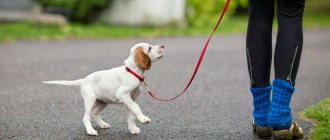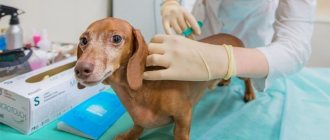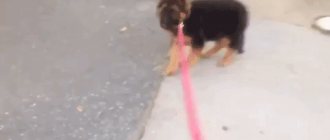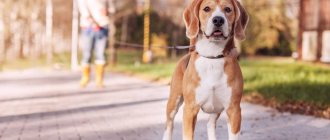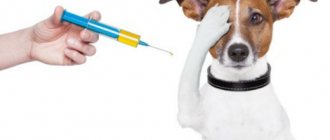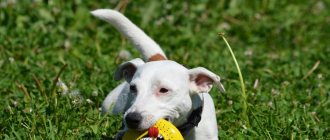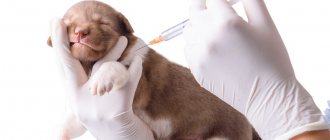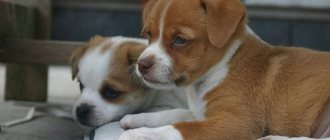Many novice breeders are interested in the Husky dog breed and how to care for it correctly. Husky is one of the ancient dog breeds, bred by the Chukchi in Siberia. This breed was bred to travel in difficult snowy areas. These dogs were also imported to America due to their excellent racing qualities. In the life of a dog there are several maintenance conditions that must be observed:
- Training and raising a dog in different conditions.
- Proper care and walking regimes.
- The best diet.
How many times and for how many hours a day should you walk your Husky?
Walking with a husky - husky walking mode walking with a husky
Good, faithful education of a Siberian husky is a matter of giving him a full walk. And this is no exaggeration. Huskies are wonderful, active dogs, but they require a special approach, especially when it comes to walking. This is a very responsible event, and certain rules must be followed in order for it to be beneficial. Firstly, you need to understand that the walk begins from the moment you put a collar on your pet and fasten a leash to it. During a walk, especially huskies in urban areas must be kept on a leash; You can only let her go in completely deserted places.
It is better not to feed your husky before going outside, but if you have fed him, you need to wait two hours and only then go for a walk. When you go outside, try not just to walk, but to run slowly.
When a person picks up a leash, the husky immediately understands that he is about to go for a walk. But the dog must learn to wait patiently for the moment when the owner says it’s time to go for a walk. Give the command to the dog to “sit” or “wait.” When you are sure that the husky is calmly waiting, you can give the command “forward” or “come out”, with these commands you confirm that the dog can walk.
To effectively train a Husky, you must understand what makes these wonderful animals act, one way or another, you need to know their psychology. As loving and playful companions, Huskies are intelligent, independent, stubborn, energetic and dominant creatures with a very strong sense of pack hierarchy. These characteristic traits are part of the Husky's personality. Taking these character traits into account when raising your pet, you will get a dog with whom it will be pleasant to live, be friends and interact as with a friend!
Walking with a Husky Make it a rule to never let an untrained Husky off the leash for a walk or leave it unattended in an unfenced area. Siberian Huskies are natural travelers, and if presented with a motivating factor (say, a squirrel or a neighbor's cat), they will immediately give chase.
walk with husky 2
By choosing outing activities that best suit your Husky's temperament and physical abilities, you will also promote success in training. Don't forget that the husky's original function is to transport loads over long distances, day after day, in harsh conditions. Everything related to these sports:
dog sledding, whitepulling is a competition of dogs to pull a load over a certain distance, skijoring is a sledding sport in which a cross-country skier moves freely along a ski distance together with one or more dogs, hiking, cycling or rollerblading, Agility training - Agility is a competition in which a person guides a dog through an obstacle course. All types will be a good choice! Some huskies, if they have been trained to do so from childhood, love to swim, but they are not water dogs, so don't be too upset if your dog doesn't want to get his feet wet. internet source
When are you going to do your homework? In addition to walks, you need training on the site, it costs a lot of money, it is desirable to participate in races - and this takes time, this includes physical training and special training
Source
How long to wait before your first walk
Of course, any owner who is concerned about the health of their pet is interested in the question of when can they walk their puppy. The first walks should start smoothly. It is important that the dog can get used to the street and not be afraid of the surrounding vegetation and other pets.
The first walk with the puppy should be in warm weather
You also need to know at what age the puppy can be taken for its first walk. So, with strong and healthy pets, you can go for a walk at the age of one and a half months. There are two conditions for such a walk:
- the weather should be warm outside, that is, at least 10 degrees;
- The pet must be held in your arms.
In all other cases, the optimal age is 3 months, when the dog has already received a course of vaccinations. Already at this age, the puppy can walk on its own, and not in the arms of the owner.
The age at which you can walk your puppy also depends on the breed. For example, large guard breeds need to be accustomed to the street from childhood, unlike short-haired representatives. Therefore, it is necessary to organize walks at the age of one month. Decorative breeds do not tolerate bad weather, so the best solution would be to wait until they get stronger and are vaccinated.
Important! The puppy should be taken for a walk in your arms, since its bones are still weak, and it is forbidden for it to move on stairs. This is especially true for the French bulldog breed, which is vulnerable to various types of severity.
Pet owners should find out if their pet's mother is vaccinated. If she has had all her vaccinations, then by the time she gives birth she has strong immunity, which means that the puppy is protected from infection for up to 3 months. In this case, you don’t have to hold him in your arms while walking.
How many times a day should you walk your dog?
In most cases, a walk with a four-legged pet comes down to quickly relieving yourself without maintaining safety or maintaining cleanliness. Because of this, animals lack socialization and activity, and all other members of society suffer from their aggression and massive pollution of lawns. All these problems cannot be ignored. To solve them, owners need to not only familiarize themselves with the basic rules, but also remember 2 very important points: how many times a day and how long to walk the dog.
How to properly walk a puppy without vaccinations
Not all pet owners have had their pet vaccinated. Of course, you can walk an unvaccinated puppy, but you must carefully monitor its behavior on the street and subsequently upon arriving home.
Owners also need to know when they can start walking their puppy outside without vaccination and how to do it correctly. So, you can take him outside for no more than 1 hour. If he feels uncomfortable, then you need to return home as soon as he relieves himself.
Important! In order for the pet to develop correctly, it must be allowed to walk with other dogs.
If you limit your dog's communication, in the future he may display unreasonable aggression towards his own kind or cowardice. The social circle for a puppy without vaccinations should be chosen personally. It is best to let him walk with domestic dogs that are vaccinated. If he is not vaccinated, you can vaccinate yourself with Nobivak.
Why are four-legged animals taken for walks?
In addition to relieving yourself, daily walks help solve several other important tasks. These include:
communication with other four-legged animals and people;
satisfaction of the hunting instinct;
maintaining good physical shape;
an opportunity to release pent-up energy.
Neglecting regular walking is fraught with attacks of sudden aggression, disobedience and excess weight gain. Animals that rarely go outside are more likely than others to attack strangers and damage their owners’ things.
How do you know when a dog is ready for breeding?
The following signs indicate that the bitch is ready for mating::
- The husky girl no longer chases away male dogs or snaps at them, but, on the contrary, she herself shows interest in them and allows them to approach her.
- The loop has become softer, the only hard part remains near its base.
- The previously bloody discharge became lighter, yellowish and pink in color.
- When you touch the loop or lower your hand onto the pet’s croup, it moves its tail to the side.
Some bitches go into heat without bloodshed, and therefore it is impossible to determine their readiness for mating by the color of their discharge..
In this case, it is recommended to focus on other signs, such as attitude towards male dogs or reaction to touching a loop.
In the same case, if the owner has doubts about the readiness of the pet for mating, he can take her to the clinic, where specialists, using a special analysis, will be able to determine whether the time has come for mating or not.
How many times a day should you walk your dog?
Age directly affects how often you need to walk your dog. The younger she is, the more energy and strength she has.
With a puppy
The puppies are walked 4-6 times a day for 10-15 minutes. This amount is explained by the fact that small pets do not yet know how to control their bladder. Frequent walking makes toilet training easier. The most optimal time to go outside is immediately after a night's sleep and before it, as well as after each meal.
If you have enough free time, walk your pet every 2-3 hours. This way he will get used to the toilet faster. After this, the breaks are increased, reducing the number of walks to 3-4 times.
With an adult dog
Adult healthy animals are walked 2-3 times a day. Their bladder can easily withstand a break of 10-12 hours. But, if your job allows you to do this more often, then it is better to increase the number of trips outside. Extra physical activity will benefit both you and your pet.
How to teach a dog to tolerate going to the toilet?
Be patient and wait for the moment when the pet does its business. Eventually the puppy won't be able to stand it
for a long time.
As soon as the dog understands the principle of walking and begins to relieve himself on the street, begin weaning him from going to the toilet
at home. Remove the diapers, leaving 1-2 for the first time.
Interesting materials:
What is the root of chestnut? What paint should I use to paint a metal water container? What is the best wet food for cats? What kind of moss can be used in an aquarium? What kind of beam is needed for the ceiling? What is the volume of a goldfish aquarium? What color are Siamese cats? Which finger should you insert into the pulse oximeter? What is the pH of spring water? What kind of PC is needed for Pubg Mobile?
How long should you walk your dog?
The average walking time for adult animals is 1.5-2 hours. But how long you can walk your dog is influenced by two more important factors: breed and weather conditions.
Depending on the breed
It is important to consider the size and purpose of the breed. The larger and more active your pet, the more time you should devote to it.
The recommended time and immediate program for the upcoming route for different breeds is as follows:
Toy breeds and companion dogs. Yorkies, Pekingese and Pugs need 1-1.5 hours a day. They easily get used to the tray, and to warm up their paws, periodic runs around the apartment are enough for them. Such dogs are walked at a calm pace so as not to tire them ahead of time.
Herding, guard, hunting, service and sledding. All these breeds are working breeds. They are walked 2-4 hours a day. Regular outings are complemented by active activities: joint jogging, cycling and training on dog parks.
Fighting ones. This group should be considered separately. The main goals of walking here are socialization and education. The more time you devote to training, the better. If any problems arise, contact your dog handler immediately.
Please note that fighting and working dogs are not suitable for workaholics. Lack of activity has a detrimental effect on their psyche. A bored animal may begin to attack its owners or dig tunnels in the sofa.
Depending on weather conditions
Not only the duration of going outside, but also what time to walk the dog depends on weather conditions. In summer, it is better to go out in the morning or late afternoon, when the sun has not yet risen or is already beginning to set. But in frost, slush and wind, it is recommended to reduce the total walking time - so that the animal does not have time to catch a cold.
Particular attention should be paid to small and hairless breeds. They quickly overheat and constantly freeze. To maintain a comfortable body temperature during the cold season, they need warm overalls.
When to walk your adult dog after vaccination?
Adult dogs who are already one year old are vaccinated annually, and with a whole complex. A separate injection is often added to the injection, which contributes to the formation of resistance to rabies.
There is no clear schedule for vaccinating male dogs. For females, the vaccination period is selected depending on estrus and mating. In this case, it begins one month before mating begins.
A vaccinated dog, when mated, is subsequently able to give birth to healthy offspring. At birth, puppies receive strong immunity for up to 3 months without vaccinations.
After vaccination, adult dogs should be walked separately from other animals.
It is not prohibited to go for a walk with an adult dog. However, towards the end of the year of life, immunity weakens. Therefore, before and after vaccination, an adult dog should be taken out separately from other dogs for 2 weeks, without allowing heavy loads. To protect your pet, it is better to extend the quarantine period to 3 weeks, as there is a risk of contracting rabies. Plague also poses a threat.
If it’s winter outside, you shouldn’t give your pet a full bath after a walk. It is enough to wash only the paws. If there is a need to clean the fur, it is best to do this with dry shampoo.
At the end of quarantine, the dog is gradually returned to its usual rhythm of life. They remove the ban on swimming in reservoirs, especially if this happens in the summer, and communicating with other dogs. In summer, the dog is shown frequent withdrawal.
Important! The formation of swelling at the injection site is not a pathology and does not require consultation with a veterinarian.
Special walking situations
In addition to age, breed and weather conditions, several more factors need to be taken into account: pregnancy, lactation, estrus period and the presence of diseases.
Little puppies
Children are taken outside after receiving all required vaccinations. Until this moment, they are walked only on private territory in the courtyard of their own house.
Pregnant and lactating bitches
During pregnancy, it is recommended to reduce activity and go outside more often (3-4 times a day). The uterus pressing on the bladder increases the urge to urinate.
If your pet has already given birth, then during the lactation period it is better to walk her in a special overall. It will protect your nipples from damage.
Bitches in heat
Females in heat attract males, so try to walk in secluded places. Leave an hour earlier or later than other dog walkers to keep unwanted contact to a minimum.
Be sure to monitor your pet's well-being. If she looks tired and refuses her usual route, feel free to go home.
Animals with diseases
Recommendations depend on the diagnosis. Each disease has its own limitations:
Infections. Strict ban on contact with other animals. The walking time depends on the well-being of the infected person.
Pathologies of the musculoskeletal system. Restrictions apply to jumping, running and any intense exercise.
Diseases of the gastrointestinal tract and genitourinary system. In case of incontinence, animals are walked 4-6 times a day.
Cardiovascular diseases. Fresh air is good for the heart, so walks at a leisurely pace are welcome. Light activity is also allowed, but at the first sign of discomfort it must be reduced.
The postoperative period should be highlighted separately. Here you need to rely on medical recommendations.
Why do you need to walk your puppy outdoors?
For full development, it is important to provide a healthy dog with active movement, and the street is perfect for this. In addition, during a walk, new smells and sounds are learned, which is also an important part of development. On the street, the puppy gets to know other animals, looks attentively, remembers their habits and learns to interact with them.
Dogs need walks in the fresh air
Being in the fresh air, the dog learns the rules of behavior. In this case, all responsibility lies with the owner, because the training of commands and the future behavior of the baby depend on him.
For pets, except decorative breeds, the street is a place where they can relieve their natural needs. To this end, the owner must teach the puppy to go to the toilet outside. If this is not done, then permanent puddles at home are guaranteed.
Having found out how many months you can walk with a puppy, you need to gradually begin to accustom your pet to going outside the apartment.
Important! Frequent walks with puppies and adult dogs are a must. Huskies, terriers, spaniels, jacks, corgis and labradors especially enjoy long walks. These breeds need space, so it is better to choose parks and forests for walking.
Rules for walking
The rules for walking four-legged animals are regulated by Federal Law No. 498. The latest amendments regarding the safety of others and maintaining cleanliness came into force on January 1, 2022.
Safety Compliance
In public places, animals are strictly walked on a short leash. If the dog belongs to a potentially dangerous breed (fighting), then a muzzle is added to the mandatory equipment.
Walking without a leash is allowed only in special areas (far from children's and educational institutions) or outside the city, where there are no other people. Please note that this rule applies not only to large but also small breeds. A Chihuahua is unlikely to harm a passerby, but it will easily suffer if it frightens a person with its sudden barking.
Keeping it clean
Another important point is waste disposal. Always carry bags and a dustpan with you to clean up after your pet. It is recommended to dispose of the waste itself in special boxes, but if they are not available, a regular trash can will do. In Moscow and St. Petersburg, throwing organic waste into ordinary trash cans is prohibited.
Taking care of your dog's health
Consider the weather conditions before going outside. In rain and frost, the animal needs warm clothes, and in hot weather - a bottle of water. If you live in the city center, pay attention to dog boots. They will protect against reagents.
An equally important point is education. Teach your pet commands that prohibit picking up questionable foods from the ground. A well-timed “Ew” can save a life.
In addition to the ban, three more commands are useful: “Near”, “To me” and “Sit”. Thanks to them, you can always attract attention or calm down a playful dog.
Keeping a puppy in an apartment
If the puppy will live in an apartment or house, take care of the rules:
- Prevent the animal from having access to electrical appliances, wires, household chemicals and other dangerous items.
- Huskies have remarkable ingenuity and courage, and are able to direct these undeniable advantages to “bad” deeds. Make sure your puppy is safe in your home.
- The pet's place should be in a secluded corner, away from drafts and extreme heat. Place your dog's bedding away from radiators and heaters, away from doors, to avoid the risk of being hit or crushed by the door.
- Some puppies, left in a locked room, begin to scream, whine, and ask to go to the master's bedroom, once in which they calmly fall asleep and do not bother their owners until the morning. If you don't mind having a baby in the bedroom, place a rug in the corner. Do not take your dog to bed - firstly, it is harmful to the spine, and secondly, there is a risk of accidentally crushing the pet by turning over in its sleep or sitting on the bed.
Which dogs can you refuse a daily walk with?
Owners of small and dwarf breeds may refuse daily walks. These pets include Japanese Chins, Chihuahuas, Pomeranians, Shih Tzus and other babies. All of them easily get used to the tray and quite quickly spend the energy accumulated during the day after several laps around the room.
This group also includes larger representatives - pugs. These four-legged animals have very low activity. They are so lazy that you have to work hard to get them outside. The pug is walked only to maintain normal weight.
Points to consider while walking
A walk should bring joy to your pet. It is necessary to organize it competently so that it is exciting, active and, most importantly, safe.
There are a number of rules for walking that the owner should consider:
- You need to start walking gradually, and you need to find out from the veterinarian at what age you can walk your puppy so as not to catch an infection.
- It is recommended to go for a walk to a special dog park. If there is none, then you need to choose a secluded, quiet place and, most importantly, away from the road. For example, dachshund dogs especially enjoy walks near a pond.
- It is necessary to accustom your pet to the route gradually. So, for 3-4 weeks you need to walk the same road to the place of walking.
- The dog must be kept on a leash. You can let him off the leash, but only if the dog reacts calmly to people and other animals.
- To be able to redirect your pet’s attention, you should take toys that can captivate him when going for a walk.
- Gradually, the dog needs to be taught to follow commands. The best helpers in this case will be treats that you need to take for a walk.
- While walking, you need to make sure that the dog does not pick up food from the ground.
- Attempts at aggression towards other pets and people must be sharply suppressed.
- The dog should be prohibited from relieving itself at the entrance.
The benefits of walking
Walking is beneficial not only for four-legged animals, but also for their owners. By neglecting them, you miss out on a lot of opportunities.
For pet
The main benefits for the dog were described earlier. Regular walking socializes, satisfies innate instincts, strengthens the immune system and has a beneficial effect on physical fitness.
For the owner
The points about strengthening the immune system and physical activity are also relevant for owners. Walking in different weather conditions strengthens the body, has a beneficial effect on the musculoskeletal system and the heart, and also reduces the risk of developing varicose veins and obesity.
It is equally important that it is easier for dog lovers to make new acquaintances, and frequent contact with the four-legged dog strengthens its attachment. The last point makes the training process easier.
Why some owners don't walk their animals enough
There are quite a few reasons for this, but most often the problem lies in the lack of free time and simple laziness. If you are not ready for early rises, walks immediately after work and going outside in any weather, consider purchasing a more unpretentious pet.
Unlike cats, dogs not only can, but also need to be walked. Lack of physical activity has a detrimental effect on their physical and mental health. Before you get a four-legged pet, make sure that you can handle its maintenance and care.
Source
What should I dress my child in?
The principle of selecting clothing is based on its suitability to weather conditions. If it’s hot outside, the baby can be dressed in a bodysuit (or blouse). Very young children are usually covered with a light diaper. Accordingly, cooler weather requires that the baby wear rompers, additional blouses, a suit and a hat. More convenient are modern overalls, which replace several things at once and are convenient for quickly dressing a child. Overalls can be winter, demi-season and very light (made of thin knitwear, so-called slip overalls).
Winter overalls in combination with a sleepsuit or blouse and rompers are used at air temperatures below +5°C.
Some mothers prefer to use envelopes for walking with their children in the first weeks of life. Envelopes also come in different varieties - from a lightweight version (for example, made from fleece fabric) to a rather warm, fur one.
Husky care
Huskies are hardy dogs with good health. If you take proper care of your pet, it can live up to 20-25 years. However, many owners do not follow the rules of care, which is why the husky begins to feel sad and has health problems. For example, some dog breeders forget that this breed was bred to ride sleds. Therefore, regular physical activity is an essential part of a husky's life. Being locked up all day long makes the dog feel unhappy. We will talk about other rules for caring for a husky later.
Answer
For good health, any puppy needs proper and high-quality care. Huskies are no exception.
In the first months after birth, a husky puppy is able to live in a city apartment and outside in an enclosure.
When choosing housing for a pet, consider this fact: a baby raised on the street subsequently has better immune protection and better coat quality. Keeping them in an enclosure is a salvation for the apartment – furniture, carpets, floors. Husky is a sociable dog, if you decide to raise the dog in an enclosure, get ready to pay maximum attention. A dog raised in close contact with its owners is more affectionate.
How to care for a husky: a matter of nutrition
Let's start with how often you need to feed individuals of different ages.
Up to 2 months – six times a day.
From 2 to 4 months – five times a day.
From 4 to 6 months – four times a day.
From 6 to 10 months – three times a day.
From 10 months to 1.5 years – 2 times a day.
Adult dog – 1-2 times a day.
You have a choice: feed your dog regular, “human” food or buy ready-made food.
If you plan to feed your husky regular food, remember that meat should make up 50-60% of the diet. The most preferred option is beef. Rabbit and turkey work well. Be careful with the chicken. It causes allergies in many individuals. If you decide to give your dog chicken, carefully monitor its health. If you detect the slightest problems with skin, coat, eyes, or general well-being, reconsider your diet. Huskies are prohibited from feeding lamb and pork. Give the meat lightly cooked or raw.
You can give your dog egg yolks 1-2 times a week. They can be either cooked or raw. You can add fermented milk products to your diet. It is better to feed your husky cottage cheese or kefir than raw milk, as it may give your pet an upset stomach. It is allowed to feed the dog vegetables. The exception is potatoes. A good option is porridge: for example, rice, oatmeal, buckwheat. Add a little vegetable (olive, sunflower, pumpkin, sesame, hemp) oil or fish oil to your food. It is strictly forbidden to give your dog peanut butter, cocoa butter, coconut oil, cottonseed oil and palm oil. Butter should also not be added to the diet, as it harms the animal’s liver.
Don't forget about vitamins. They support the husky’s immune system, improve the condition of the skin, coat, and eyes. Ask your veterinarian about what vitamins you should give your dog and in what quantity.
If you decide to feed your pet store-bought food, you should not save too much. Cheap feeds contain raw starch. This component is difficult for the husky's body to tolerate.
Puppies under 10 months of age should be given special puppy food. Important! Switch to the “adult” version no later than ten months. Otherwise, your husky may develop hip dysplasia. Choosing the right food for this breed is a difficult task. A dog may have individual characteristics that do not allow it to eat a particular food. Monitor your pet's health after eating food.
As for adults, it is better to give preference to food for active dogs. Let us remind you: Husky is a breed that has a craving for physical activity. In order for the body to allow the dog to run and play as much as possible, it needs to be saturated with proteins and healthy fats. Specialized feeds have all this. You can give your husky both dry and wet food.
If you have any questions regarding your animal's nutrition, please contact your veterinarian. A specialist will select the right food and vitamins. This way, you won't need to experiment with your pet's health.
Why do puppies need quarantine for the first 2 weeks after vaccination at 3 months?
To protect the life of your pet, after a course of vaccinations, you must comply with quarantine. Animal immunity develops faster against a number of diseases, but protection against leptospirosis and rabies appears only 2 weeks after the course has been completed.
After vaccination, the dog's activity decreases for several days
After vaccination, the dog's behavior must be closely monitored. In the first three days, the dog is characterized by a decrease in activity. Babies may whine in fear. Side effects are also noted:
- refusal to eat;
- itching;
- lethargy;
- intestinal disorders;
- increase in temperature.
A veterinarian's consultation is required if your dog behaves in the following ways:
- The dog itches, chokes, the mucous membrane turns blue. All these are symptoms of anaphylactic shock.
- The temperature reaches 39 degrees, accompanied by weakness, cramps, vomiting and frustration.
Is quarantine mandatory?
Although it seems that vaccination is a fairly simple procedure, after it the dog’s body becomes weakened. During this period, your pet can contract a number of diseases that can be fatal. This is why quarantine is not only possible, but required.
In this case, it means complete isolation from society. If for an adult dog such restriction from the outside world is not necessary, then for a puppy it is vital.
Rules of conduct for 2 weeks after administration of the vaccine:
- Limit the puppy's interaction with other animals.
- Limit contact with objects that may contain viruses (outdoor shoes, etc.).
- Give up the idea of walking your pet.
- Avoid water procedures.
- Do not introduce changes to your usual diet.
- Reduce physical activity.
Important! During immunization, it is worth asking your veterinarian when the puppy can be taken outside. He will be able to determine the time period if the owner is afraid to make a decision himself, and will tell him when walking will be allowed.
Caring for a Husky in the Heat
Although this breed was bred in the cold northern regions, the dog can withstand hot summers without harm. Huskies have a thick undercoat that absorbs heat from direct sunlight. As a result, the dog's body temperature does not change much.
However, there is a second side to the coin. During serious physical activity, heat comes from the dog’s body. It is difficult for the same undercoat to pass through (this is also why huskies do not freeze during severe frosts). As a result, the sun gives its dose of heat, and the body - its own. This greenhouse effect creates discomfort for the husky and is dangerous. Therefore, during the heat, you should not put too much stress on your pet. Also, make sure your dog always has access to water.
Why is there no heat?
With good general health and the state of the reproductive and hormonal systems, the dog's first heat occurs at the established usual times and then repeats with a certain cyclical regularity. If the dog is older than 18 months, and the first heat has not come, you should consult a veterinarian to find out the reason for this delay.
The main reasons for the delay/absence of the first heat:
- poor living conditions, improper or insufficient feeding;
- disruption of hormonal regulation of the reproductive system;
- congenital disorders in the development and structure of the genital organs;
- ovarian dysfunction (hypofunction, lack of appropriate hormones during the appropriate period);
- dysfunction of the pituitary gland and/or thyroid gland;
- tumors and/or other neoplasms, cysts of the pelvic organs or directly on the ovaries;
- endocrine pathologies;
- chronic inflammatory processes in the uterus;
- hermaphroditism (for example, when underdeveloped testes are found instead of ovaries).
Husky paw care
Huskies are active animals that can “pick up” a lot of things on their paws in one walk. We strongly recommend washing them after each visit to the street. If you live in a private home and your dog spends time in the yard, wash its paws as they become dirty.
If your dog's paws are not too dirty (which happens after short walks), it is recommended to use regular cool water. Soap should be used in “severe” cases. Dog shampoo diluted in water in a ratio of 1 to 5 is excellent for washing paws. It is worth cleaning not only the pads, but also the space between them. After bathing, paws should be dried with a regular towel.
In the context of paw care, caring for a Husky in an apartment is more complex than in a country house. The fact is that a large amount of substances that harm the pads accumulate on city roads. This includes salt, settled exhaust, and dirt with impurities, which is carried by thousands of people. To protect your dog's paws, you can apply a wax ointment or paste to the skin. They can be purchased at pet stores. The product must be applied before walking. It creates a film that protects paws from irritation and the negative influence of temperatures. In addition, many ointments and pastes have a healing effect. After a walk, the product should be washed off.
You can also use dog boots to protect your paws. They protect not only from the above factors, but also from mechanical damage.
It is recommended to apply softening dog cosmetics to the skin of the paws every 3-4 days. It will protect against discomfort and irritation. Human means cannot be used. Firstly, they are not suitable in composition. Secondly, the dog will certainly lick off the harmful “chemicals”, which will attract it with its aroma. If it is not possible to get specialized products, you can use a small amount of vegetable oil. More difficult to obtain is goose fat.
During its races and games, your pet can damage its paw. Treat the resulting crack with a dog emollient antiseptic until complete healing. Apply the product 2-3 times daily. If the crack does not heal for more than a week, take your husky to the vet. The same must be done when stains appear.
In case of a shallow cut, you need to wash the wound and treat it with hydrogen peroxide. Over the next four to five days, it is necessary to treat the wound with an antiseptic: for example, a solution of furasol. If the injury is serious, of course, it is better to go to the vet after stopping the bleeding. If this is not possible, do the following: remove foreign objects from the wound, if there are any, treat with hydrogen peroxide, apply a liquid plaster. In the future, use an antiseptic. The dog may chew on the wound. In this case, you need to bandage it. Dog boots can be used to protect the wound while walking.
If your dog is licking a wound, do not stop it from doing so. Saliva contains a powerful antiseptic that promotes speedy healing. The exception is if you have just applied medicine to a wound.
Trim your nails regularly. This is especially true for huskies, who spend little time outside, and their claws do not wear off on the asphalt. As soon as they start to curl, trim them. To do this, you should purchase a dog nail clipper. Don’t skimp on this device: the better quality it is, the less discomfort the trimming procedure will bring to your pet. Remember one more rule: more often is better, but safer. Trim just a few millimeters, otherwise there is a risk of touching the vessel.
Which is better, a collar or harness for a husky puppy?
Every person faces this choice. What is better to choose? In fact, both the first and second options are good. a harness for a husky is still better suited . The pet will feel as natural and comfortable as possible in it. It does not interfere or hinder movement, but, at the same time, allows you to easily coordinate your pet.
Choosing a harness for a husky is not difficult. It is best to go with your pet to a pet store and, after trying it on, choose the most suitable one. If this is not possible, calculate the size of the husky harness by taking measurements from the animal with a centimeter.
By the way! Give preference to adjustable models so that in the future, as the animal grows older, you will not have to run for another one again.

